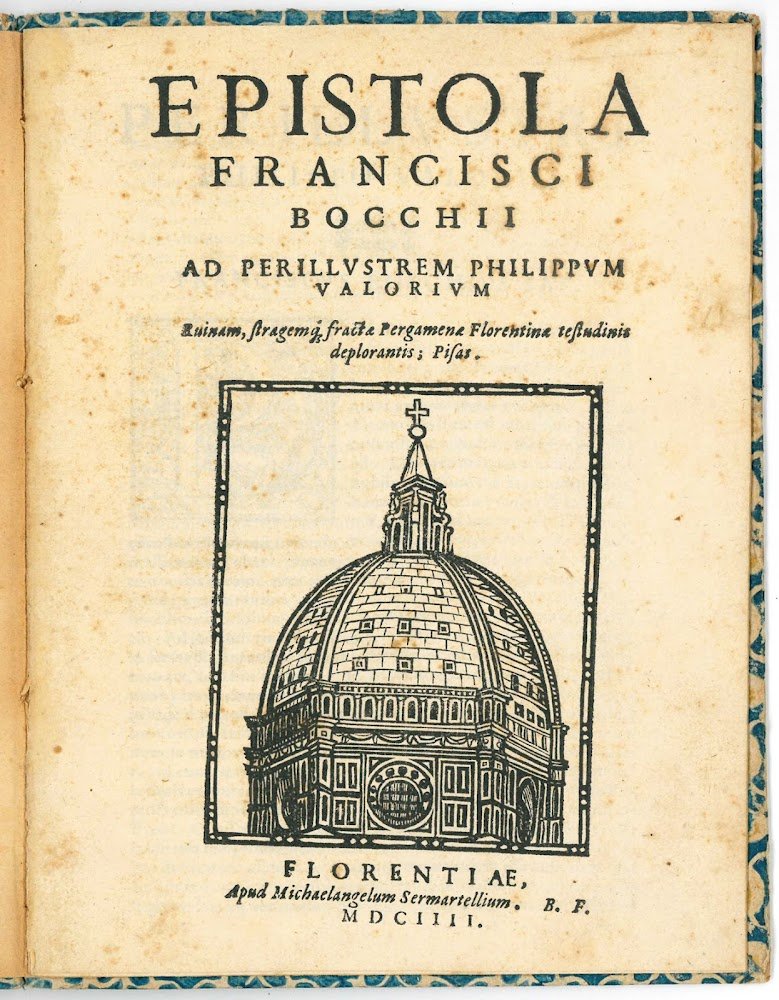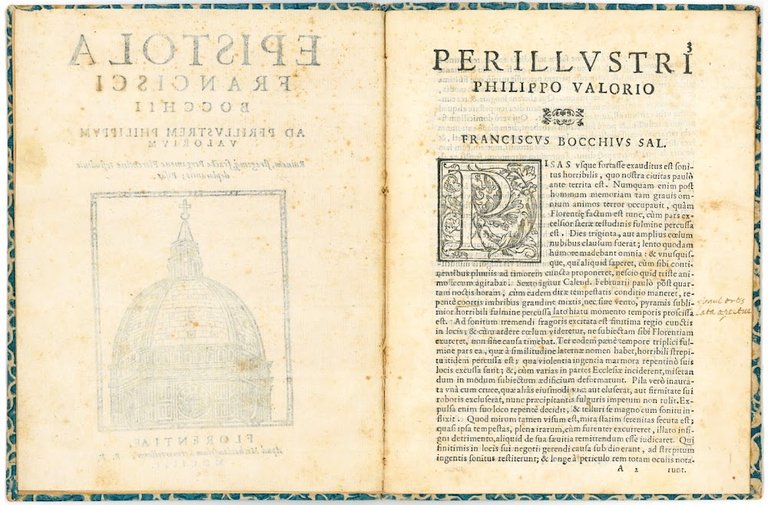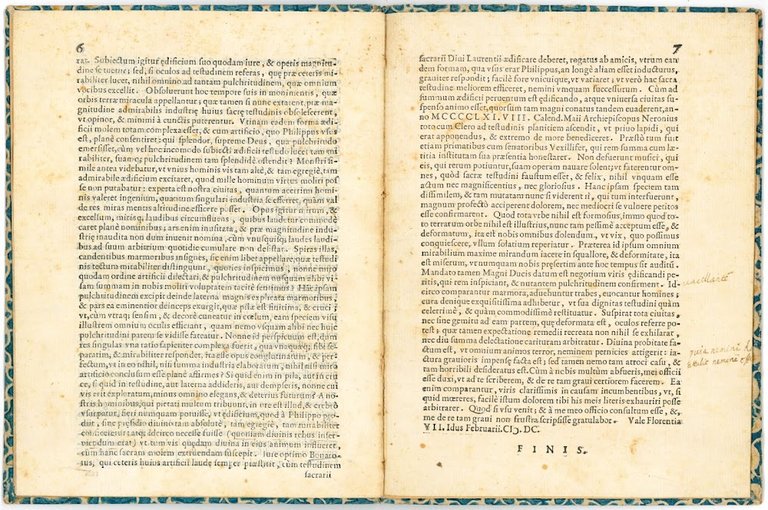


Libri antichi e moderni
BOCCHI, Francesco (1548-1618)
Epistola Francisci Bocchii ad perillustrem Philippum Valorium ruinam, stragemque fractae pergamenae Florentinae testudinis deplorantis; Pisas
Michelangelo Sermartelli, 1604
2800,00 €
Govi Libreria Antiquaria
(Modena, Italia)
Le corrette spese di spedizione vengono calcolate una volta inserito l’indirizzo di spedizione durante la creazione dell’ordine. A discrezione del Venditore sono disponibili una o più modalità di consegna: Standard, Express, Economy, Ritiro in negozio.
Condizioni di spedizione della Libreria:
Per prodotti con prezzo superiore a 300€ è possibile richiedere un piano rateale a Maremagnum. È possibile effettuare il pagamento con Carta del Docente, 18App, Pubblica Amministrazione.
I tempi di evasione sono stimati in base ai tempi di spedizione della libreria e di consegna da parte del vettore. In caso di fermo doganale, si potrebbero verificare dei ritardi nella consegna. Gli eventuali oneri doganali sono a carico del destinatario.
Clicca per maggiori informazioniMetodi di Pagamento
- PayPal
- Carta di Credito
- Bonifico Bancario
-
-
Scopri come utilizzare
il tuo bonus Carta del Docente -
Scopri come utilizzare
il tuo bonus 18App
Dettagli
Descrizione
4to (202x152 mm). 7, [1 blank] pp. Collation: A4. Large woodcut vignette on title page showing the Brunelleschi dome of the Florence cathedral. Woodcut decorative initial. With a few contemporary marginal annotations correcting specific terms in the text or clarifying certain passages. Later boards covered with colored paper. Some light foxing, a good copy.
Rare original edition of this letter sent to Filippo Valori, the pope's ambassador in Florence. Although published only in 1604, the letter is dated 7 Februrary 1600, a few days after the dome of the Florence cathedral had been struck by a lightning bolt that during the night of the 27th January damaged the lantern on top of the cupola.
It is the first of two letters written by Bocchi on this subject; the other one, entitled Epistola seu opusculum Francisci Bocchii De restitutione sacræ testudinis Florentinae, addressed to Francesco Nicolini and dated 29 August 1603, was also published by Sermartelli in 1604, with the same woodcut of the cupola on the title page.
In the letter Bocchi is mostly concerned with the restoration of the cupola, which was entrusted to the architect Gherardo Mechini, who designed an ingenious scaffolding and elevation machine system, and completed the work by 1 November 1601 (cf. G. Salvagini, Gherardo Mechini architetto di Sua Altezza: architettura e territorio in Toscana 1580-1620, Florence, 1983, p.106).
Bocchi also celebrates the famous dome, for him one of the pinnacles of Florence artistic magnificence, in front of which “primo laetitia, deinde, cum appropinquant, admiratio, postremo stupor” are the emotions experienced by the viewer. Its creator, Filippo Brunelleschi, is also praised; Bocchi refers that Michelangelo, at the time when he was entrusted with the works of the dome for the Church of San Lorenzo, asked by some friends whether he would imitate or distance himself from the work of Brunelleschi, replied by saying that it would be easier to change but no one had done better than Brunelleschi.
Francesco Bocchi was born in Florence in 1548. Having completed his studies in literature and eloquence, around 1572 he moved for some time to Rome, where he made friends in the Curia circles. Returning to Florence, he led a difficult and precarious existence as a professional man of letters, devoting himself mainly to the education of young noblemen, such as the sons of Benedetto Vivaldi and Piero Antonio Strozzi, and publishing numerous occasional writings, such as encomiastic orations, rhetorical exercises, parenetic letters, and small treatises composed on commission or in the hope of some sort of remuneration. His contemporaries were generous to him with praise and recognition, but not with financial support. The most important of his patrons was Lorenzo Salviati. Bocchi died in Florence in 1618. His printed works include: Discorso a chi de' maggion Guerrieri che insino a questo tempo sono stati, si dee la maggioranza attribuire (Florence, 1573); Oratio de laudibus Ioannae Austriae quae Regina nata Ungariae, et Boemiae, in matrimonio Francisci Medicis, Magni Ducis Etruriae, Florentiae infelici Partu mortem obiit (Florence, 1573; the Italian version, translated by Bocchi himself, appeared at Florence in 1578); Discorso.sopra la lite delle Armi et delle Lettere (Florence, 1579); Discorso sopra la Musica (Florence, 1580); Eccellenza della statua del San Giorgio di Donatello Scultore Fiorentino, posta nella facciata di fuori d'Or San Michele (Florence, 1584); Oratio de laudibus Petri Vectori viri clarissimi (Florence, 1585); Le bellezze della città di Fiorenza dove a pieno di Pittura, di Scultura, di sacri Tempij, di Palazzi i più notabili artifizi e i più preciosi si contengono (Florence, 1591; one of the first guides of the city made by itineraries); Opera sopra l'immagine miracolosa della Santissima Nunziata di Fiorenza (Florence, 1592); Oratio de laudibus Philippi I

